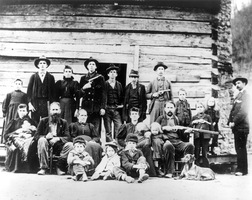 | Back to e-WV
| Back to e-WV
 The West Virginia Encyclopedia
The West Virginia Encyclopedia
 | Back to e-WV
| Back to e-WV
 The West Virginia Encyclopedia
The West Virginia Encyclopedia

The Hatfields are West Virginia’s most famous family, known worldwide for their bloody feud with the McCoys in the 1880s. The family had settled in the Tug Valley by 1800, when Ephraim and Anna Musick Hatfield moved their household from Russell County, Virginia, to the Kentucky side of Tug Fork. Hatfields eventually dispersed to both sides of the river, with the main branch of the family living in (West) Virginia by the time of the Civil War.
There are two founding events in Hatfield family history: A 1792 Shawnee raid in Russell County, which widowed Anna Musick and eventuated in her marriage to Ephraim, who was among the party that rescued her from the Indians. And in 1817, preacher Abner Vance fled a Russell County murder charge, finding refuge in Tug Valley. Vance later returned to Virginia and was hanged there, but not before establishing a family line on Tug Fork.
Hatfield and Vance blood united in the generation of Anderson ‘‘Devil Anse’’ Hatfield (1839–1921), whose mother was Nancy Vance. It was Devil Anse and his uncle, the fierce Jim Vance, who led the war against the McCoys, a neighboring Tug Valley family living largely in Kentucky. Hatfields generally bested their foes in the fighting and raids of the feud, but suffered more serious legal consequences in the ensuing trials. A Hatfield kinsman was convicted and hanged in Kentucky in February 1890, and another imprisoned.
Devil Anse Hatfield’s nephew, Henry Drury Hatfield (1875–1962), was elected governor of West Virginia in 1912. Governor Hatfield was a medical doctor by training, who had helped to establish organized medicine in the southern coalfields. He was president of the state Senate before his term as governor, and later served as U.S. senator (1929–35). Hatfield was a progressive Democrat, best remembered for imposing the ‘‘Hatfield Settlement’’ which ended the bloody Paint Creek-Cabin Creek coal strike of 1912–13.
Attempting to abate the feud, Anse Hatfield in 1888 moved across the mountain from Tug Valley to Main Island Creek, south of Logan town, and in 1911 was baptized by his old comrade, the preacher ‘‘Uncle Dyke’’ Garrett. Anse died in 1921 and is buried with his immediate family under an imposing marble statue of himself at Sarah Ann. Today numerous Hatfields live throughout West Virginia’s southwestern counties and in neighboring Kentucky. They are prominent in local politics, in business, and in medicine and other professions. The Hatfields break bread in occasional reunions with the McCoys, and in the summer of 2000 they were beaten and bathed by their old adversaries in a spirited Tug Fork tug-of-war.
Many books and articles have been written about the Hatfields and the feud they engaged in, as well as movies, plays, and songs. The Hatfield family name, often in combination with the name of their McCoy rivals, has been used to name businesses, events, and other ventures, including the Hatfield-McCoy Trail, a system of off-road trails running through several counties of southern West Virginia. In 2013 the recently discovered Tug Valley Crayfish was given the Latin scientific name Cambarus hatfieldi by the West Liberty University biologist who first identified the species.
Written by Ken Sullivan
Rice, Otis K. The Hatfields and the McCoys. Lexington: University Press of Kentucky, 1982.
Hatfield, Elliott. The Hatfields. Stanville, KY: Big Sandy Valley Historical Society, 1974.